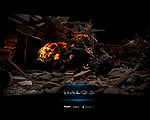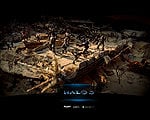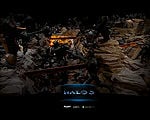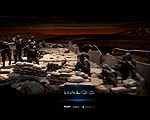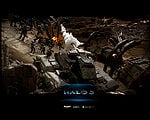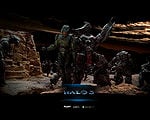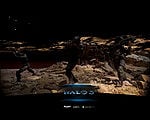Second Battle of Mombasa
From Halopedia, the Halo wiki
Template:Not Canon Template:Battle The Second Battle of Mombasa was a bloody engagement between United Nations Space Command and Covenant forces that is depicted in the John-117 Monument. The battle itself, or at least some of the events depicted, never actually occurred, but it serves as a summary of the final days of the Human-Covenant War and John-117's ultimate sacrifice.[1][note 1]
Background
On October 20, 2552, the Prophet of Regret, having suffered heavy casualties on the ground at the hands of the Master Chief, entered Slipspace from within New Mombasa, unleashing a powerful explosion that caused great damage to the city - heavy enough to sever the city's space tether, causing its catastrophic collapse onto the Kenyan Savanna. The severed Covenant ground forces and the UNSC defense forces surged forward into the city to secure whatever prize or tactical advantage the ruins might have held.
Later, human and Covenant forces clashed again in the ruins, both forces surging forward to capture it. The battle took place in the weeks immediately after the Prophet of Regret's retreat to Installation 05, lasting until John 117's return to Earth aboard the Prophet of Truth's Forerunner Dreadnought.
Elements from both the 506th Tank Regiment and the 77th Marine Regiment battled furiously for it, with snipers from both sides taking a heavy toll upon the enemy. Ultimately, the battle lasted seven days, with the UNSC forces in a desperate situation. With ammo becoming scarce and all hope seeming lost, that is when John-117 stepped into the battle.
Timeline
Battle for the landing zone
The battle began on the outskirts of New Mombasa, where UNSC and Covenant forces engaged each other in a bitter fight for control of a Landing Zone. The UNSC never gained full control of it, always being pushed back by the Covenant whenever they seemed to secure it and vice versa.
The northern bridge falls
Despite a valiant defense by the Marines, there was no way they could hold the bridge for much longer. With Brute forces surging over it and hitting the Marines' vulnerable flanks, there was only one option remaining. At 14:00, the order came through to destroy the bridge, to force the enemy down into the Valley where UNSC trenches lay to slaughter the enemy with fire from elevated positions. However, this was not the case as the Covenant forces had already begun to surge down the trenches with the destruction of the Bridge.
The hill
The most ferocious and bloody bottleneck in the battle, the UNSC forces sent to defend it took 2/3rds casualties. After the second bridge was destroyed, the trenches at the foot of here, a last ditch defensive measure, came under heavy attack, garnering heavy Marine casualties.
Snipers
Snipers from both sides battled for control, with UNSC Snipers fighting on one end of the destroyed southern bridge and Covenant Jackal snipers halting Marines outside the Landing Zone before being routed by UNSC infantry and tanks.
The 506th arrive
Tasked with securing a road to the southern bridge span, the 506th Tank Regiment plowed forward, taking heavy casualties. Though outnumbered, they took their objective, leaving a path for the second wave of UNSC infantry to follow.
John's gambit
It was at the top of the "Hill" bottleneck that John-117, launched a gambit to retake the hill for the UNSC forces, by allowing himself to be captured by Brute forces there.
Notable UNSC combatants
- Pawel Czernek- Major Pawel Czernek, who was active for 30 years in the UNSC from 2551 to 2581. He was one of the few surviving combatants who fought in The Battle of New Mombasa. Filmed in a documentary circa the turn of the 27th century at the Museum of Humanity. He related his role in the battle while examining a diorama of the battle - he manned an overturned Warthog's turret - and described the morale Master Chief engendered during the battle ("We knew Master Chief was in the fight. He gave us hope.") The elderly Maj. Czernek wears a prosthetic metal right leg. It is unclear where or when he suffered that traumatic injury.[2]
- Ian Callahan- A soldier who was captured by two Jackals during the Battle of New Mombasa, and saved by an unknown Marine.[3]
- James Dessen- Corporal James Dessen was posthumously awarded a Red Legion of Honor medal for his extraordinary bravery during the Battle of New Mombasa.[3]
- Thomas P. Porter- A Scorpion tank driver during the Battle of New Mombasa.[3]
- Thomas Chang- Sergeant Chang was a veteran of numerous battles with the Covenant, and successfully completed the task of securing a forward HQ during the Battle of New Mombasa. He was killed during a Covenant air assault.[3]
- Jackson Law- The sole survivor of a Warthog patrol during the Battle of New Mombasa. He sustained serious injuries when his warthog was destroyed by Covenant plasma bombardment.[3]
- Sian Wong- A UNSC sniper during the Battle of New Mombasa. Sustained severe burn injuries from a retaliatory Banshee strike.[3]
- Russel Tinnier- A UNSC marine during the Battle of New Mombasa assigned to destroy a strategic bridge.[3]
- Thomas C. Meyer- A UNSC marine who used his rocket launcher to destroy the bridge alongside Tinnier.[3]
- Emmanuel Lomax- "Emmet" Lomax encountered Master Chief Petty Officer of the Navy, John-117 during the Battle of New Mombasa, after receiving a precious 4 hours sleep in an abandoned building.[3]
- Caio Zanato- Sole survivor of his squad during the Battle of New Mombasa, promoted to the rank of Private First Class.[3]
- Niraj Shah was a UNSC sniper during the battle on the Hill.[3]
Theories
Template:Conjecturalization As the diorama was supposedly made as part of a museum display many years after the war, it may in fact be an intentional distortion of what actually happened by the Office of Naval Intelligence's Section Two, in order to prevent knowledge of the Halo Array, and the Ark from being gained by the general public, or to enforce John-117's status as a near-mythical heroic figure. This would fit with the fact that there has been no further mention of the battle.
As seen in Halo 3: ODST, the explosion caused by Regret's escape caused relatively superficial damage to the city, rather than razing it, which occurred according to the Believe campaign. On the morning of October 21st, 2552, the entire city and the surrounding area were glassed by the Covenant in order to unearth the portal structure. When John-117 returned to Earth on November 17, he fought in the Tsavo region and the town of Voi, though he never returned to Mombasa.
John-117's capture by a Jiralhanae chieftain and his use of a grenade to escape might have been influenced by similar events inside the Forerunner Dreadnought before it arrived at Earth, where the SPARTAN was indeed captured by a Brute and interrogated, before sticking his captor with a plasma grenade and escaping.[4] Template:Conjecturalization End
Note
- ^ This battle was portrayed in the Believe advertising campaign prior to Halo 3's release. The fashion in which it is portrayed is considered to be non-canon. Microsoft was not aware of Halo 3's story during the development of the Believe campaign, and the battle is not depicted in Halo 3 or concurrent media, such as Halo: Uprising. The fate of New Mombasa as depicted in the diorama was later contradicted: Halo 3: ODST reveals that the city sustained relatively minor damage during Regret's escape and was glassed hours later, and that a protracted battle never occurred in the city's ruins.
Gallery
Marine fire teams defeat Brute forces outside of the LZ.
See also
Sources
